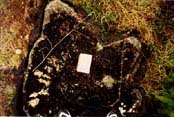 The Shady Beach fire occurred in September of 1988 and covered around 9000
acres. Much of the area was young (less than 30 years old) Douglas-fir
plantations. As we learned in class these young plantations generally burn
hot and thoroughly. This was no exception. Although a large amount of
post-fire salvage logging went on in this area, many of the stumps are from
logging operations before the fire. On the stump to the right you can see
from the carbon on top that it was burned in the fire. You can also see
that it was quite a large tree (on top is a
Handbook of Oregon Trees and Shrubs.
The Shady Beach fire occurred in September of 1988 and covered around 9000
acres. Much of the area was young (less than 30 years old) Douglas-fir
plantations. As we learned in class these young plantations generally burn
hot and thoroughly. This was no exception. Although a large amount of
post-fire salvage logging went on in this area, many of the stumps are from
logging operations before the fire. On the stump to the right you can see
from the carbon on top that it was burned in the fire. You can also see
that it was quite a large tree (on top is a
Handbook of Oregon Trees and Shrubs.
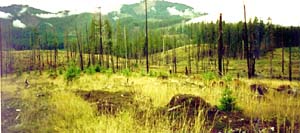 Most of the trees growing here before logging were probably
Douglas-fir Pseudotsuga menziesii. A few pockets of these
older trees remain. While the fire killed most of the plantation trees
(like those on the left),
the remaining old growth was not as affected. Young Douglas-fir are
not as fire tolerant as when they get older and the structure of a
plantation is conducive to stand-replacing burns. Because in young
closely stocked stands the horizontal and vertical continuity lead to
high susceptibility to fire.
Most of the trees growing here before logging were probably
Douglas-fir Pseudotsuga menziesii. A few pockets of these
older trees remain. While the fire killed most of the plantation trees
(like those on the left),
the remaining old growth was not as affected. Young Douglas-fir are
not as fire tolerant as when they get older and the structure of a
plantation is conducive to stand-replacing burns. Because in young
closely stocked stands the horizontal and vertical continuity lead to
high susceptibility to fire.
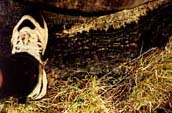 One of Douglas-fir's major
adaptations to fire is its thick bark. The tree to the right has bark a
foot thick in some places. Another reason older Douglas-firs are
resistant to fire is that in shady conditions they are self pruning, i.e.
they lose their lower branches. With no lower branches and a thick bark a
ground fire is not very dangerous to these tress. To be fatal a fire
One of Douglas-fir's major
adaptations to fire is its thick bark. The tree to the right has bark a
foot thick in some places. Another reason older Douglas-firs are
resistant to fire is that in shady conditions they are self pruning, i.e.
they lose their lower branches. With no lower branches and a thick bark a
ground fire is not very dangerous to these tress. To be fatal a fire
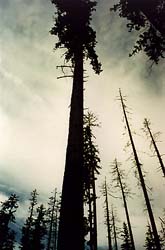 needs to get into the canopy. One way this can happen that we saw at
Shady Beach is when a young plantation is next to older trees. The
younger trees act as a fire ladder into the canopy. In one of the areas,
partially shown by the picture to the left,
we looked at how the fire probably got into the canopy from the younger
trees, burnt a
couple of crowns of the older trees, then dropped back down to the
surface. Although fire will often act in this way, as we have learned
fire is a complex and chaotic ecosystem process. At Warner Creek I have
seen mature stands of Douglas-fir seemingly untouched by fire that
torched the young plantation Douglas-fir immediately next to them. Other
times during the same fire, fire jumped to the canopy of old-growth
stands in areas with no clearcuts and few under-story trees. Fire generally
burns a mosaic pattern in the forest, sometimes slowly smoldering in the
undergrowth and other times turning into a large stand-replacing fire.
needs to get into the canopy. One way this can happen that we saw at
Shady Beach is when a young plantation is next to older trees. The
younger trees act as a fire ladder into the canopy. In one of the areas,
partially shown by the picture to the left,
we looked at how the fire probably got into the canopy from the younger
trees, burnt a
couple of crowns of the older trees, then dropped back down to the
surface. Although fire will often act in this way, as we have learned
fire is a complex and chaotic ecosystem process. At Warner Creek I have
seen mature stands of Douglas-fir seemingly untouched by fire that
torched the young plantation Douglas-fir immediately next to them. Other
times during the same fire, fire jumped to the canopy of old-growth
stands in areas with no clearcuts and few under-story trees. Fire generally
burns a mosaic pattern in the forest, sometimes slowly smoldering in the
undergrowth and other times turning into a large stand-replacing fire.
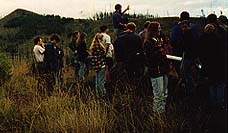
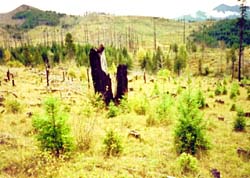
Related Links:
Douglas-fir
Insects and diseases
Fire Ecology Links
|

